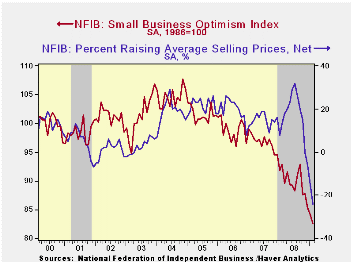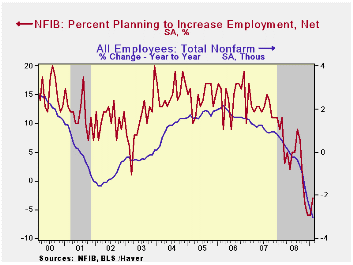 Global| Mar 10 2009
Global| Mar 10 2009U.S. Small Business Optimism Nearing All-time Low
by:Tom Moeller
|in:Economy in Brief
Summary
According to the National Federation of Independent Business (NFIB), small business optimism fell even further last month. The index level of 82.6 was down 1.8% month-to-month after a slightly revised 1.3% January decline. The latest [...]

According to the National Federation of Independent Business (NFIB), small business optimism fell even further last month. The index level of 82.6 was down 1.8% month-to-month after a slightly revised 1.3% January decline. The latest level was 8.0% below the 2008 average and it was the second lowest level on record.
During the last ten years there has been a 49% correlation between the level of the NFIB index and the two-quarter change in real GDP.
The percentage of firms planning to raise prices dropped to 1%, a new record low. Price discounts were evident as the percentage of firms actually raising prices fell further into negative territory, and the reading was a record low. During the last ten years there has been a 69% correlation between the y/y change in the producer price index and the level of the NFIB price index.
The percent expecting credit conditions to ease fell further and was near its lowest level since 1980. The percent expecting higher real sales in six months fell to a net negative 29%, a record low.
The percentage expecting the economy to improve fell further into negative territory. The percentage reporting that now is a good time to expand the business fell to 3% which was the second lowest reading on record. During the next 3-6 months, plans for capital spending fell slightly and was still near the lowest level since 1975.
The percentage planning to raise employment improved just slightly to a net negative 3% while the percentage of respondents with one or more job openings was stable at 11%, the least since 1992. During the last ten years there has been a 71% correlation between the NFIB employment percentage and the y/y change in nonfarm payrolls.
The largest, single most important problems seen by business were poor sales (33%), taxes (19%), government requirements (10%), insurance cost and availability (8%), competition from large businesses (6%) and inflation (6%).
About 24 million businesses exist in the United States. Small business creates 80% of all new jobs in America.
The NFIB figures can be found in Haver's SURVEYS database.
Financial Reform to Address Systemic Risk is this morning's speech by Fed Chairman Ben S. Bernanke at the Council on Foreign Relations, Washington, D.C. It is available here.
| Nat'l Federation of Independent Business | February | January | Y/Y | 2008 | 2007 | 2006 |
|---|---|---|---|---|---|---|
| Small Business Optimism Index (SA, 1986=100) | 82.6 | 84.1 | -11.1% | 89.8 | 96.7 | 98.9 |
Tom Moeller
AuthorMore in Author Profile »Prior to joining Haver Analytics in 2000, Mr. Moeller worked as the Economist at Chancellor Capital Management from 1985 to 1999. There, he developed comprehensive economic forecasts and interpreted economic data for equity and fixed income portfolio managers. Also at Chancellor, Mr. Moeller worked as an equity analyst and was responsible for researching and rating companies in the economically sensitive automobile and housing industries for investment in Chancellor’s equity portfolio. Prior to joining Chancellor, Mr. Moeller was an Economist at Citibank from 1979 to 1984. He also analyzed pricing behavior in the metals industry for the Council on Wage and Price Stability in Washington, D.C. In 1999, Mr. Moeller received the award for most accurate forecast from the Forecasters' Club of New York. From 1990 to 1992 he was President of the New York Association for Business Economists. Mr. Moeller earned an M.B.A. in Finance from Fordham University, where he graduated in 1987. He holds a Bachelor of Arts in Economics from George Washington University.






